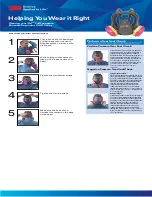
5
FA Flow Control
ENGLISH
5. Maintenance
It is recommended to clean the respiratory system after
each use. Also inspect all parts and replace any which are
damaged or worn.
• Always clean the respiratory unit in a ventilated room
or outside. Be aware of harmful dust settled on any
parts of the unit.
• Never use flammable cleaning liquids or abrasive
cleaners!
• The outer surface of the blower unit can be cleaned
with a soft cloth and mild detergent solution. The
unit must be completely dry before assembling the
filler and cover.
• Ensure that no water or detergents enter the blower
unit!
• The air hose itself, detached from the blower unit and
the headpiece, can be rinsed in clean water.
6. Filters
The respiratory power unit is equipped with a high
efficiency particle filter of class P R SL.
The filter must be checked regularly and replaced when
necessary. See section 4.2: "Air flow test".
Make sure that the new filter is within its expiry date,
unused and not noticeably damaged.
From the hygienic point of view the maximum working
time of a filter is 180 hours and should not be exceeded.
6.1 Changing filter
Remove the filter cover:
6
1. Pull the locking clips outwards and move the filter
cover off the unit.
Note! Never use any tools to uncover the filter.
Remove the filter:
7
2. Turn the filter and pull it away from the main body.
3. Remove any dust with a soft cloth.
Insert a new filter:
8
4. If you are using a prefilter or an odor filter, place
and fix it around the new filter as tightly as possible,
sticking the ends together using the sticky tape
located on the ends of the prefilter or odor filter.
5. Put the filter back into position using the same
rotating motion and gently push until it fits well
onto the body of the unit.
6. Put the filter cover back. Ensure you snap the cover
into place on both sides.
7. Battery
Note! The battery must be charged before the first
use.
The charger must not be used for any other purpose
than that for which it was manufactured. Please read the
following precautions:
• Do not charge the battery where there is a risk of
explosion.
• The battery charger is intended for indoor use only.
• The charger must be protected against damp.
7.1 Removing and inserting the battery
9
7.2 Charging the battery
1. Check that the voltage of the electrical power
supply is correct.
2. Plug the charger into the socket.
3. Remove the battery from the unit and connect it to
the charger.
4. Once the battery is fully charged, a green LED is lit.
5. Disconnect the charger from the power supply.
The charger controls the charging automatically. After
the battery has been charged, the charger switches to
maintenance mode and keeps the battery fully charged.
Charging time is 4 – 5 hours.
Note! Do not leave the charger in the power supply
if not in use !
8. Storage
All parts of a FA Flow Control system must be stored in an
environment with temperature between -10 – 55 °C and
humidity between 20 – 80 % Rh. The storage life is 2 years
for the product if stored in its original unopened package.
Note! Batteries get discharged even if not in
use. Therefore for long-term storage it is highly
recommended to charge the batteries for an hour
every 3 months.
9. Warranty
There is a 12 month warranty covering production defects
and a 6 month warranty for batteries.
The warranty begins from the date of purchase. The claim
must be lodged with the dealer. The paid invoice or receipt
must be produced if claiming on the warranty.
The claiming procedure will be successful only if there were
no changes made on the blower unit including the battery
and charger.
If the damage is caused by not changing a clogged filter
in time or using a filter which has been cleaned by the
customer, the claim will not be processed.



















